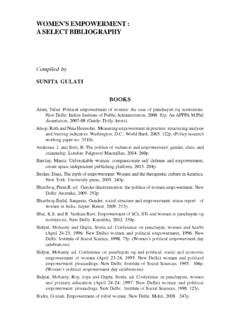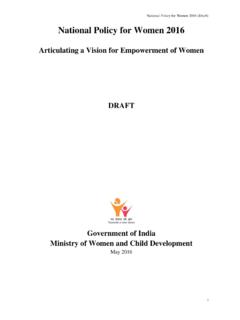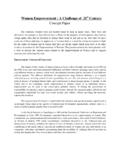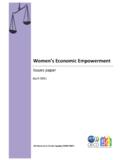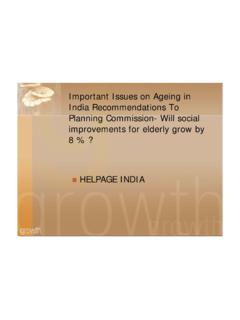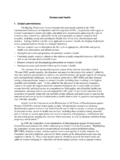Transcription of EMPOWERMENT OF WOMEN IN INDIA: A …
1 EMPOWERMENT OF WOMEN IN INDIA: A critical ANALYSISMAMTA MOKTAThe principle of gender equality is enshrined in the IndianConstitution in its Preamble, Fundamental Rights,Fundamental Duties and Directive Principles. The Constitutionnot only grants equality to WOMEN , but also empowers the stateto adopt measures of positive discrimination in favour ofwomen. EMPOWERMENT may be described as a process whichhelps people to assert their control over the factors which affecttheir lives. EMPOWERMENT of WOMEN means developing themas more aware individuals, who are politically active,economically productive and independent and are able to makeintelligent discussion in matters that affect them. Presentarticle discusses about various initiatives taken by Governmentof india for empowering WOMEN by analysing position of Indiain Gender Inequality Index and Global Gender Gap Index ofUnited Nations.
2 Article concludes with the note that duerecognition must be given to WOMEN and society should comeforward to ensure equal status for WOMEN in all spheres oflife. EMPOWERMENT MAY be described as a process which helps peopleto assert their control over the factors which affect their lives. Empowermentof WOMEN means developing them as more aware individuals, who arepolitically active, economically productive and independent and are ableto make intelligent discussion in matters that affect Womenempowerment as a concept was introduced at the International womenConference in 1985 at Nairobi, which defined it as redistribution of socialpower and control of resources in favour of The United Nations1U. Koko, Empowering People for Health and Family Planning , IASSI Quarterly, , p.
3 2, Panucha and Ankita Khatik, EMPOWERMENT of Rural Woman , Social Action,Vol. 55, p. 349, / INDIAN JOURNAL OF PUBLIC ADMINISTRATION474 /VOL. LX, NO. 3, JULY-SEPTEMBER 2014 Development Fund for WOMEN (UNDFW) includes the following factorsin its definition of WOMEN EMPOWERMENT : Acquiring knowledge and understanding of gender relations andthe way in which these relations may be changed. Developing a sense of self-worth, a belief in one s ability to securedesired changes and the right to control one s (1974) defines EMPOWERMENT as the process of challengingexisting power relation and of gaining greater control over the source ofpower . WOMEN s EMPOWERMENT is seen as the process and the result ofthe process of: Challenging the ideology of male domination and WOMEN ssubordinations. Enabling WOMEN to gain equal access to and control over theresources (material, human and intellectual).
4 4 EMPOWERED WOMEN S CHARACTERISTICS(i)Empowered WOMEN define their attitude, values and behavioursin relation to their own real interest. They have autonomybecause they claim their freedom from existing male hierarchies,whether they live in traditional societies or modern industrialsocieties.(ii)Empowered WOMEN maintain equal mindedness. They act outroles that challenge male dominance. They respond as equalsand co-operate to work towards the common good.(iii)Empowered WOMEN use their talent to live fulfilling lives. Theynot only survive the harshness of their own subjugation but alsotranscend their subjugation.(iv)Empowered WOMEN maintain their strength on the face ofpressures from the religion and work and contribute towardsthe EMPOWERMENT of all WOMEN .(v)Empowered WOMEN define their values and formulate theirbeliefs themselves, they do not derive their sense of being frommale authorities nor do they live vicariously through Ganeswamurthy, EMPOWERMENT of WOMEN in india Social Economics andPolitical , New Century Publications, New Delhi, p.
5 4, Kumari and Yadav, Economic Reform and EMPOWERMENT of WOMEN : Issues,Options and Concerns , in Thakur and Thakur (eds) Impact of Economic ReformPolicies on Dalit and Weaker Sections, Deep & Deep Publications, New Delhi, p. 106, Parmecha and Ankita Khatik, , p. 353, OF WOMEN IN india / 475 MAMTA MOKTAD imensions and Parameters of WOMEN EmpowermentThe process of EMPOWERMENT has five dimensions, viz. Cognitive,psychological, economic, political and physical:(i)The cognitive dimension refers to WOMEN having anunderstanding of the conditions and causes of their subordinationat the micro and macro levels. It involves making choices thatmay go against cultural expectations and norms;(ii)The psychological dimension includes the belief that womencan act at personal and societal levels to improve their individualrealities and the society in which they live;(iii)The economic component requires that WOMEN have access to,and control over, productive resources, thus ensuring somedegree of financial autonomy.
6 However she notes that changesin the economic balance of power do not necessarily altertraditional gender roles or norms;(iv)The political element entails that WOMEN have the capability toanalyse, organise and mobilise for social change; and(v)There is a physical element of gaining control over one s bodyand sexuality and the ability to protect oneself against sexualviolence to the EMPOWERMENT parameters of WOMEN EMPOWERMENT are: Raising self-esteem and self-confidence of WOMEN . Elimination of discrimination and all forms of violence againstwomen and girl child. Building and strengthening partnership with civil societyparticularly WOMEN s organisations. Enforcement of constitutional and legal provisions andsafeguarding rights of WOMEN . Building a positive image of WOMEN in the society and recognisingtheir contributions in social, economic and political sphere.
7 Developing ability among WOMEN to think critically. Fostering decision-making and collective action. Enabling WOMEN to make informed choices. Ensuring WOMEN s participation in all walks of life. Providing information, knowledge, skills for / INDIAN JOURNAL OF PUBLIC ADMINISTRATION476 /VOL. LX, NO. 3, JULY-SEPTEMBER 2014 Elimination of discrimination against WOMEN s participation in theareas of: Access to food Equal wages Property rights Family resources Freedom of movement and travel Access to credit Control over savings, earnings and resources Guardianship and custody of children and theirmaintenance Gender sensitisation training in schools, colleges and otherprofessional institutions for bringing about institutional have to swim against the stream that requires mere strength comes from the process of EMPOWERMENT .
8 The womenempowerment can be done through providing proper education, health andnutrition of WOMEN EmpowermentBeijing Conference 1995 had identified certain quantitative andqualitative indicators of WOMEN EMPOWERMENT . These indicators arediscussed below:Qualitative Indicators:(i)increase in self-esteem, individual and collective confidence;(ii)increase in articulation, knowledge and awareness on health,nutrition reproductive rights, law and literacy;(iii)increase in personal leisure time and time for child care;(iv)increase on decrease of workloads in new programmes;(v)change in roles and responsibility in family and community;(vi)visible increase on decrease in violence on WOMEN and girls;(vii) responses to, changes in social customs like child marriage,dowry, discrimination against widows;(viii) visible changes in WOMEN s participation level attendingmeetings, participating and demanding participation.
9 (ix)increase in bargaining and negotiating power at home, incommunity and the collective;7 Sandhya Rani Das, EMPOWERMENT of WOMEN : A Holistic Approach , WOMEN Educationand Development, Discovering Publishing House, New Delhi, 2006, pp. Manikandan, V. Raju and T. Taghu, WOMEN EMPOWERMENT for india s Development ,Also see, Ganeswamurthy, , pp. 173-174, OF WOMEN IN india / 477 MAMTA MOKTA(x)increase access to and ability to gather information;(xi)formation of WOMEN collectives;(xii) positive changes in social attitudes;(xiii) awareness and recognition of WOMEN s economic contributionwithin and outside the household;(xiv) WOMEN s decision-making over her work and Indicators(a)demographic trends maternal mortality rate fertility rate sex ratio life expectancy at birth average age of marriage(b)Number of WOMEN participating in different developmentprogrammes;(c)Greater access and control over community resources/government schemes creche, credit cooperative, non-formaleducation;(d)Visible change in physical health status and nutritional level;(e)Change in literacy and enrollment levels.
10 And(f)Participation levels of WOMEN in political of WOMEN EMPOWERMENT : Four components of WOMEN sempowerment are identified:(i)Acquiring knowledge and an understanding of gender/powerrelations and ways in which these relations may be changed;(ii)Developing a sense of self-worth, a belief in one s ability tosecure desired changes and the right to control one s life;(iii)Gaining the ability to generate choices and thereby acquiringleverage and bargaining power; and(iv)Developing the ability to generate, organise or influence thedirection of social change to create more just social andeconomic orders nationally and OF WOMEN EMPOWERMENT To identify gaps in the EMPOWERMENT of WOMEN , development ofchildren and adolescents; Create a national network of pubic, private and NGO centres fordelivering reproductive and child health services free to any client; / INDIAN JOURNAL OF PUBLIC ADMINISTRATION478 /VOL.
